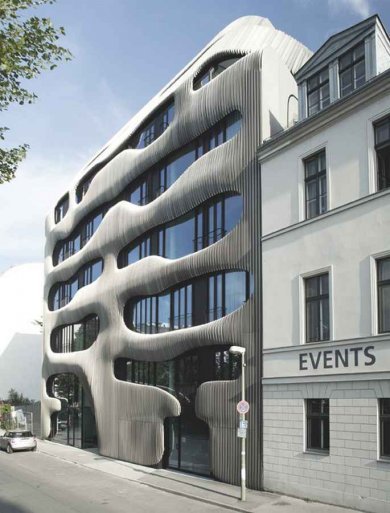Berlin buildings

“Between the Lines”: Daniel Libeskind and His Design Plans
Architect Daniel Libeskind’s “Between the Lines” design won the competition in 1989 for the “Extension of the Berlin Museum with a Jewish Museum Department.” It was the first time that one of his designs was actually built.
The Libeskind building is outwardly freestanding and independent. To reach the permanent exhibition, visitors must walk through an underground passageway from the entry area in the adjacent baroque Old Building. Daniel Libeskind designed the floor plan based on two lines: the building’s visible zigzagging line and an invisible straight line. At the points where the two lines intersect are the “voids, ” empty spaces that cut through the building from the ground floor to the roof. The crisscrossing, oblique slashes of windows appear unsystematic and make it impossible to distinguish the individual floors from outside.
Libeskind mentions four different sources of inspiration for his design. Prominent Jewish and non-Jewish Berliners such as Paul Celan, Max Liebermann, Heinrich von Kleist, Rahel Varnhagen, and Friedrich Hegel stand for the connections between Jewish tradition and German culture prior to the Shoah. Libeskind plotted their addresses on a map, and a network of lines emerged from which he developed the structure of the building and the windows. Other ideas came from composer Arnold Schönberg’s unfinished opera Moses and Aaron, from the German Federal Archive’s The Memorial Book for the Victims of the Nazi Persecution of Jews in Germany (1933–1945), and from the essay “One-Way Street, ” by Walter Benjamin.
The "Voids"
The voids cut through the entire vertical axis of the building. The concrete shafts are neither heated nor air-conditioned and largely lack artificial lighting. Only some of them can be accessed. In the upper floors of the exhibition space, the voids are clearly discernible from the void bridges, whose walls are painted black. One of the five voids contains the Shalekhet (Fallen Leaves) installation by Israeli artist Menashe Kadishman (further information on the installation is available on our website).
Daniel Libeskind uses the voids to address the physical emptiness that resulted from the expulsion, destruction, and annihilation of Jewish life in the Shoah, which cannot be refilled after the fact. He wanted to make this loss visible and tangible through architecture.
The Axes on the Lower Level
Three axes cross on the lower level of the Libeskind building, symbolizing three historical developments of Jewish life in Germany: the Axis of Exile, the Axis of the Holocaust, and the Axis of Continuity, which leads to a steep staircase. Climbing eighty-two steps, visitors reach the entrance to the permanent exhibition two stories up, the final eight steps ending in front of a white wall.
We display objects along the axes that tell the stories of Jews who were persecuted and killed during the Nazi era or had to emigrate. The Rafael Roth Learning Center is located at the intersection of the three axes. More information about the Rafael Roth Learning Center on our website.
The “Holocaust Tower”
The Axis of the Holocaust ends in the “Voided Void, ” or Holocaust Tower, an isolated building splinter whose sole connection to the Libeskind building is underground. Daylight penetrates the tower only through a narrow slit in the unheated concrete silo and any exterior sounds are heavily muffled by the walls. Many visitors experience a feeling of oppression or anxiety inside the Holocaust Tower.
The Garden of Exile
The Axis of Exile leads to the Garden of Exile, which is located outside the Libeskind building. Forty-nine concrete stelae are laid out in a 7-by-7 square on slanting ground. The Russian olive bushes growing atop the stelae are a symbol of hope. Forty-eight are filled with soil from Berlin and the forty-ninth, at the center, with soil from Jerusalem.
The slanting ground of the Garden of Exile gives visitors a dizzying feeling of unsteadiness and disorientation. The only vegetation is located high out of reach. Libeskind wanted this spatial experience to recall the lack of orientation and instability felt by the émigrés forced out of Germany.
Bibliography on Daniel Libeskind’s design plans:
- Dorner, Elke. Daniel Libeskind. Jüdisches Museum Berlin. Berlin: Gebr. Mann, 1999.
- Libeskind, Daniel. Jewish Museum Berlin, Architect Daniel Libeskind with a photo essay by Hélène Binet. Amsterdam and Dresden: G+B Arts International, 1999.
- Libeskind, Daniel. “Zwischen den Linien. Der Museumsbau soll jüdische Geschichte erschließen und sichtbar machen.” In: Jüdisches Museum Berlin. Sonderpublikation zur Eröffnung. Spezial der Allgemeinen Jüdischen Wochenzeitung . Berlin: Jewish Culture Edition, 2001, 66–72.
- Pieper, Katrin. “‘Between the Lines.’ Architektonische Geschichtsreflexionen des Jüdischen Museums Berlin.” In: Christina Jostkleigreve et al., eds. Geschichtsbilder. Konstruktionen – Reflexionen – Transformationen. Cologne: 2005, 371–385.
- Willemeit, Thomas, “‘Oh Wort, du Wort, das mir fehlt!’ Musik und Architektur bei Daniel Libeskind.” In: Archithese 28/5 (1998): 18–24.






